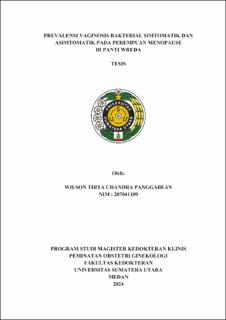Prevalensi Vaginosis Bakterial Simtomatik dan Asimtomatik pada Perempuan Menopause di Panti Wreda
Prevalence of Symptomatic and Asymptomatic Bacterial Vaginosis in Postmenopausal Women at an Elderly Nursing Home

Date
2024Author
Panggabean, Wilson Tirta Chandra
Advisor(s)
Siregar, Muhammad Fidel Ganis
Haryono, Hayu Lestari
Metadata
Show full item recordAbstract
Background: Menopause is a natural and permanent process that occurs when the ovaries stop producing reproductive hormones which increase the risk of vaginal infections, including bacterial vaginosis (BV).
Methods: This research is a descriptive observational study with a cross sectional design to assess the prevalence of symptomatic and asymptomatic bacterial vaginosis in postmenopausal women at an elderly nursing home. This research was conducted at the Yayasan Guna Budi Bakti Elderly Care Center located in the Medan Belawan District of Medan City in September 2024. The population of this study consists of menopausal women residing in the Yayasan Guna Budi Bakti Elderly Nursing Home. Sample collection was conducted using the consecutive sampling technique. The data collected includes age, parity, duration of menopause, smoking status, weight, height, BMI, nutritional status, and history of vaginal discharge. Data were analyzed descriptively to see the frequency distribution. For bivariate analysis, the chi square test is used. The analysis results are considered significant if the p value is <0.05, with a 95% confidence level.
Results: The average age of postmenopausal women in this study is 72.5 ± 6.69. The most common parity status is multipara with an average menopause duration of 19.72 ± 6.50. The smoking status among the study subjects is dominated by postmenopausal women who do not smoke (96.875%). The average weight and height of the study subjects are 51.00 ± 8.93 and 151.38 ± 4.64, respectively, with the most common BMI category being overweight (40.6%). The average Nugent score in this study is 6.39 ± 2.77, with most samples falling into the bacterial vaginosis category (50%). Based on the symptoms experienced, 11 subjects (34.4%) complained of leucorrhea, while 21 other subjects (65.6%) did not experience any symptoms of leucorrhea. The differences in symptoms complained about based on the Nugent score were significant (p=0.022). The proportion of individuals (prevalence rate) experiencing bacterial vaginosis is 50%. The difference in the incidence of bacterial vaginosis based on body mass index is considered not significant (p=0.74).
Conclusions: The prevalence of postmenopausal women with asymptomatic BV is higher than those with symptomatic BV at Yayasan Guna Budi Bakti Elderly Nursing Home.
